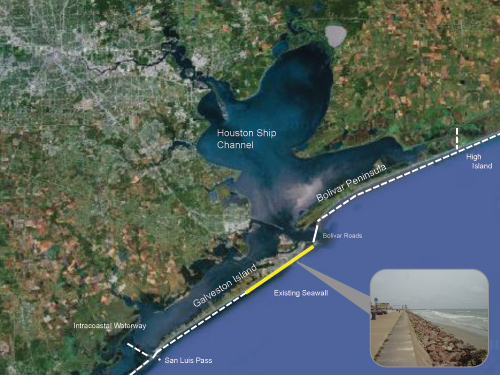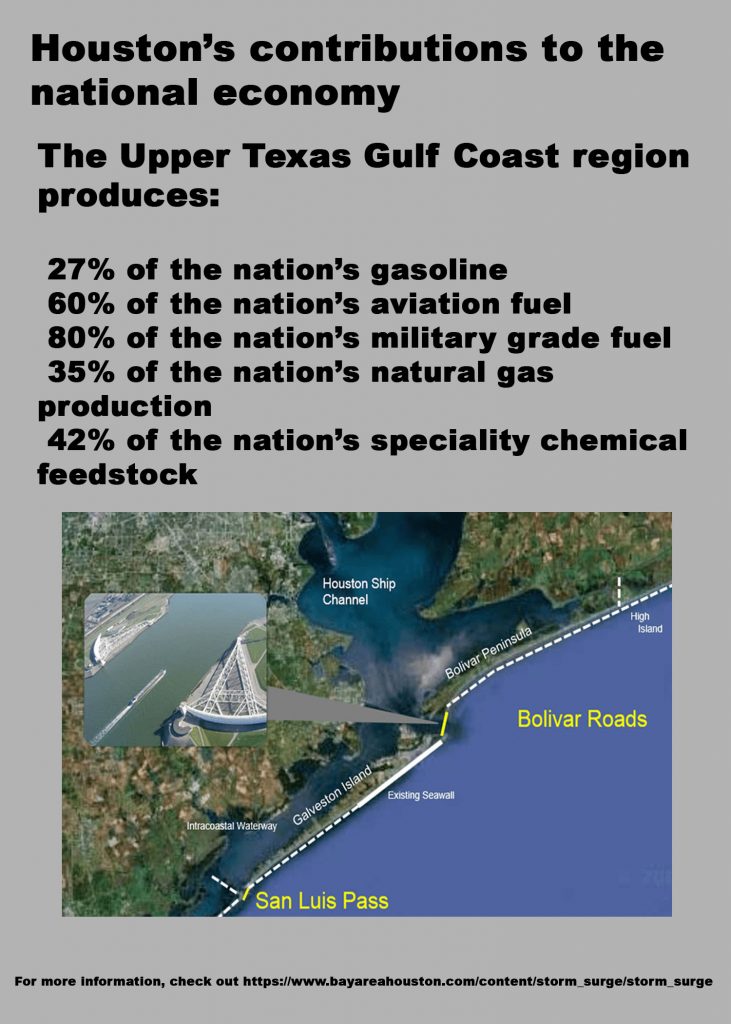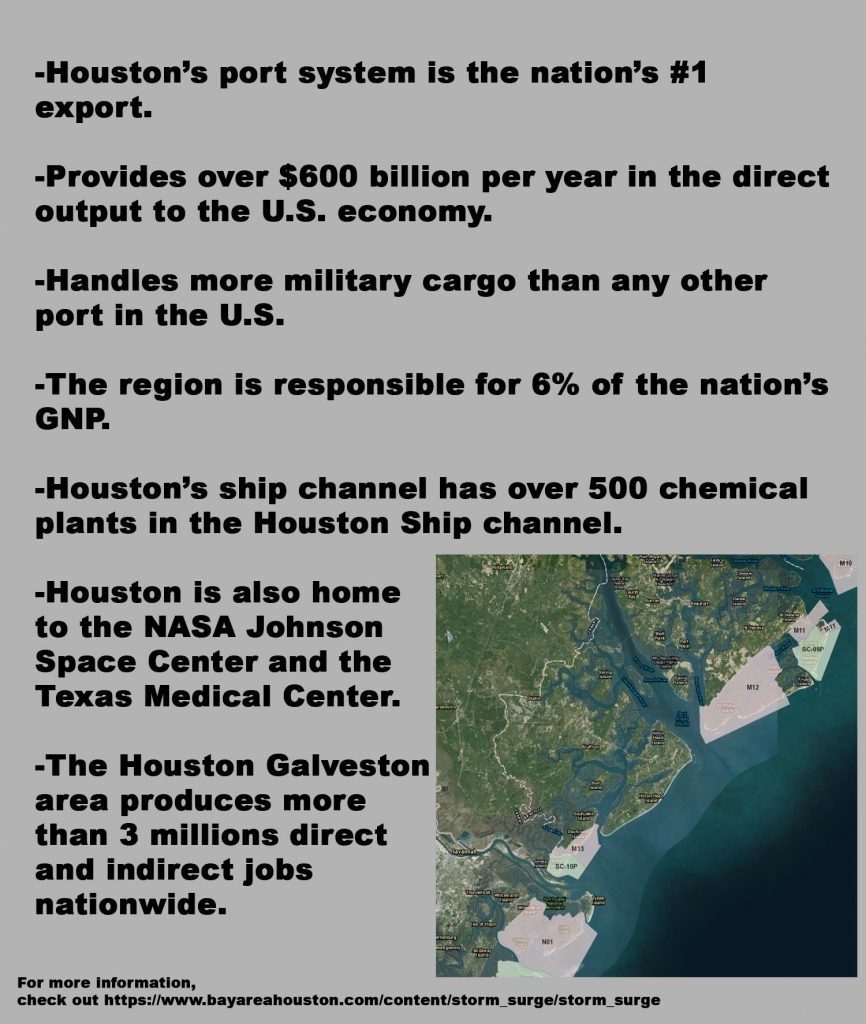
Texas officials and BAHEP push for coastal barrier as preventative hurricane damage measure
The Bay Area Houston Economic Partnership (BAHEP) is pushing to have a coastal barrier built along the Upper Texas Gulf Coast. The purpose of the barrier would be to protect the Galveston Bay Area from severe damage potentially caused by a hurricane to surrounding cities and the industries there, such as the port system and ship channels.
Bob Mitchell, president of BAHEP, said that the effort to get funding for the project came nine years ago, shortly after Hurricane Ike.
“We’ve been advocating for this barrier to be built since 2009 after Hurricane Ike,” Mitchell said. “We haven’t stopped our efforts or lessened them since then.
The idea for the project was conceived by William Merrell, professor at Texas A&M University at Galveston. The barrier was at that time, and still is at times, referred to as the “Ike Dike.”

Mitchell said that to make the central section of the barrier it would cost $5.8 billion. He further said the federal government provided $15.5 billion to New Orleans after Hurricane Katrina but will not provide $5.8 billion to Houston for the barrier.
“They built the biggest teacup to protect 300 people and not their industry,” Mitchell said. “Houston contributes six percent of the gross national product to the United States. We want to and have to protect that.”
Mitchell said New Orleans does not contribute to the country’s gross national product, but nevertheless received more money than what Houston needs to protect its multiple industries. Advocates for the barrier have said if a hurricane with a strong enough storm surge was to reach Houston, it would damage industries and set the country into an economic crisis.
“This is a national security issue,” Mitchell said. “The federal government should fund this.”
The idea for the barrier system has gained greater attention in the Houston/Galveston Bay Area, and nationwide since its conception. George P. Bush, commissioner of the Texas General Land Office, wrote a letter to President Donald Trump in March 2017 detailing the need for the barrier’s construction and funding.
The letter was consigned by over 50 representatives of different fields in the surrounding Bay Area and Houston region including: Merrell, Mitchell, Houston Mayor Sylvester Turner, the mayors of Friendswood, Deer Park, Dickinson, League City, Galveston and Kemah, six state representatives of Texas and the superintendents of the Clear Creek and La Porte Independent School Districts.
Mayor Turner has further advocated for the building of the barrier, by writing a letter of advocacy to Texas Senator John Cornyn in May 2018.
“As mayor of the City of Houston, home to more than 2.3 million people, the world-renowned Texas Medical Center, the Johnson Space Center, a concentration of petrochemical plants along the Houston Ship Channel and the Port of Houston, all vulnerable to the threat of devastating storm surge from Gulf hurricanes, I want you to know that I fully support S. 2866, the Coastal Texas Protection Act,” Turner said. “Moving forward with the coastal barrier system is crucial to protecting our citizens and our state and national economy.”
BAHEP released a video featuring workers from the oil and ship channels, Mayor Turner, representatives from BAHEP and other specialists and advocates for the barrier. The video explains the necessity for the barrier to be built and detail how Houston’s port systems region is vital to the national economy. This includes how Houston’s port is the number one export in the country and provides $600 billion per year in direct output to the U.S. economy.
There have been groups that oppose the construction of the barrier, such as the Sierra Club, considered one of the nation’s largest and most influential environmental organization. The club argues that the barrier will not offer enough protection, and could deteriorate Galveston Bay and the coastal habitat.
The Signal reached out to the Sierra Club for a comment regarding the coastal barrier, but did not receive a response at the time of publication.
However, Merrell believes the barrier to be the only way to protect the city.

“This is preventive medicine,” Merrell said to the Texas A&M Foundation’s online magazine. “The concept is easy. You stop the storm surge at the coast so that you can protect everyone.”
David Rachita, the dean of students, expressed similar sentiments about preventing damage from the next natural disaster.
“I think it is a great idea to be planning ahead for future catastrophes and that research into anything that can mitigate these disasters is worth looking into,” Rachita said. “More people need to be informed about these ideas so they can be educated.”
Mitchell said that Houston would “finally” obtain the money to fund the project “after the next disaster.”
“It’s extremely disappointing,” Mitchell said. “[The U.S. government has] an attitude that you recover rather than prevent and that’s sad. If you can prevent a disaster, then why not do so? You can spend 30 plus billion but not five billion?”
Mitchell said that further addressing of the issue can be done by contacting local Texas representatives as well.
“We will continue to push our elected officials to get the program funded,” Mitchell said. “Pick up the phone and call your elected official.”
Rachita supported Mitchell’s sentiments, saying the UHCL community can help the creation of the barrier by reaching out to representatives.
“I would echo that advice and also call the BAHEP for info regarding the project,” Rachita said.
More information on the coastal barrier can be found on BAHEP’s site and Texas A&M Galveston’s website on the topic.
